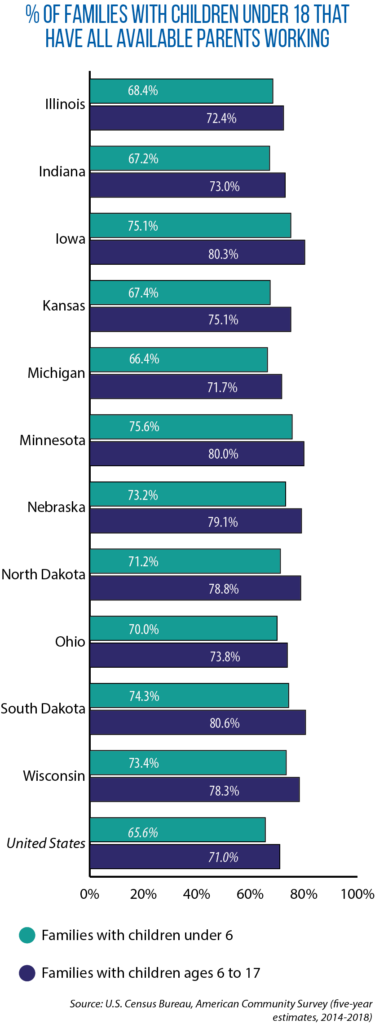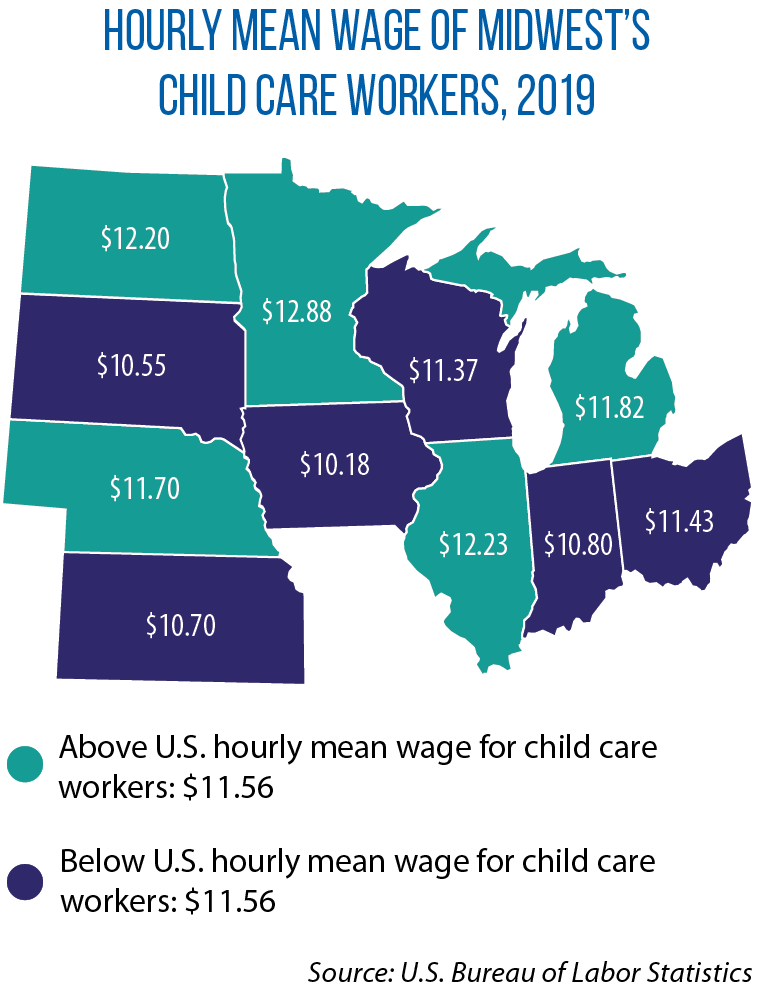Building a stronger foundation of child care
COVID-19 led to an unprecedented response to help this sector; long-term challenges remain for states to address
Snapshot from Midwest on child care policy: Recent actions
as well as unique and innovative laws »
Pick a community in Greater Minnesota, the largely rural part of the state outside the Twin Cities area, and one issue is likely to be a top concern among many of its working parents: a lack of child care options.
It’s been called the state’s “quiet crisis,” with a 2017 study from the nonpartisan, not-for-profit Center for Rural Policy and Development concluding that a 35 percent increase in state capacity was needed to meet families’ needs.
Jeff Brand, now in his second year as a state legislator, first took on this lack of child care access while on the City Council in the Greater Minnesota town of St. Peter. As the parent of two young children, the issue was personal to him. And as he learned in talks with other local leaders, the lack of child care also was a community-wide problem.
Brand and others came upon a solution: Let’s use some of the town’s economic development dollars to help home day care providers, as well as to turn one of the town’s vacant buildings into a child care center.
Brand has brought at least two lessons from that experience to his current work as a state legislator: one, the need for child care is widespread; two, public investments are needed to address the problem, which he says not only strains individual families, but constrains the economic potential of entire communities.
In the Legislature, he has proposed new state-local funding partnerships to facilitate the opening of new child care facilities in Greater Minnesota. The state’s half of his $40 million funding plan would come in the form of bonds, which the Legislature already uses to support public infrastructure projects.
“We’ve got areas in Minnesota that don’t have any child care, and that’s true for a variety of reasons,” say Rep. Brand, whose proposal (HF 423) was included in this year’s bonding bill, but without an appropriation.
“On the parents’ side, you have the problem of affordability. Say it costs $800 a month to have your two kids in child care. If a person makes $2,000 a month, you don’t have much left over. And then on the flip side of the coin, the providers aren’t making much money. You look at the costs of feeding kids, hiring staff, training, paperwork.
“When you get down to it, it’s a tough gig.”
Stabilizing the Industry
That “gig” — for larger child care centers and small, home-based providers alike — got even tougher starting in March, when the COVID-19 pandemic hit. These providers were forced to shut down for a time, then required to institute new health and safety measures upon reopening, and often had to deal with these higher costs while losing some of their business.
States and the federal government took unprecedented steps to help the child care sector, a recognition of its importance to the overall economy.
“We were incredibly worried about how to keep the industry stabilized,” says Emilie Amundson, secretary of the Wisconsin Department of Children and Families. “We knew if we lost child care, it would be difficult for our entire economy to rebound. And we also knew that when you lose child care options in a community, if people start leaving the field, it’s hard to bring them back. There are a lot of startup costs and rules to know and follow.”
In Wisconsin, as of October, the state had set aside $130 million this year for early care and education.
According to the Bipartisan Policy Center, the federal CARES Act provided state governments in the Midwest with more than $600 million in supplemental funding for child care (via the existing Child Development & Block Grant Fund).
Governors also used discretionary dollars in the CARES Act to further help providers — an additional $80 million in Wisconsin, for example. With this federal assistance, states boosted subsidy rates for providers while establishing new grant programs to help providers remain open, institute new safety measures, pay and retain their workers, and weather the financial hit from COVID-19.
‘Precarious foundation’
Concerns about child care access and affordability in Wisconsin well preceded this year’s pandemic.
Over the past 10 years, Amundson says, the state has lost almost 70 percent of its licensed family-care providers. A large majority of residents in Wisconsin’s rural areas currently live in “child care deserts,” meaning there is an insufficient supply of child care options for families.
According to Kathryn Tout, a leading expert on child care policy, states across the nation are facing similar challenges due to factors such as high costs for parents, low wages for child care workers, and low profit margins for businesses in this economic sector.
“One thing the pandemic has shown is just how precarious the foundation is that child care programs have been sitting on,” says Tout, vice president for early childhood research and partnerships at Child Trends, a national research organization whose work focuses on improving the lives of children.
That foundation is based primarily on a private pay model, with families incurring most of the costs of child care. These costs are rising, and have neared or eclipsed $10,000 a year in some parts of the Midwest (see table). Meanwhile, the hourly mean wage for child care workers ranges from $10.18 in Iowa to $12.23 in Illinois.
“Right now, we have an unsustainable difference between what it costs to provide high-quality care and what parents can pay,” Tout says.
Within this existing private pay model, some government assistance already goes to families and providers.
For example, subsidy programs run by the states (with funding support from the federal Child Development and Block Grant Fund) help lower-income families pay for child care. Through these programs, the state picks up much of the costs, though families are often responsible for some kind of co-payment.
These programs have varying income caps, and some states have recently raised those limits in order to make more families eligible for assistance.
Michigan’s new budget raised the income-eligibility cap for child care assistance from 130 percent to 150 percent of the federal poverty level. In Illinois, some families with incomes as high as 225 percent above the federal poverty level can now receive state support for child care.
According to the National Women’s Law Center, South Dakota’s income cap was 209 percent in 2019, and as of last year, it was the only U.S. state that fully exempted low-income families from co-payments related to child care.
The center says there is another important policy difference among the states: the rate at which they pay providers serving families who receive the child care assistance.
The U.S. Administration for Children and Families recommends that a state’s payment rate for providers be equal to at least 75 percent of the market rate in a local community. Only North Dakota and South Dakota were meeting this threshold as of 2019, according to the center.
Lessons from the pandemic
In Wisconsin, Amundson says, one way to create a stronger foundation for child care is to build on what’s already there — namely, higher levels of public support via the existing subsidies, payment systems and grant programs.
Tout says the same is true across the country.
“The pandemic and the [government’s] response, in terms of the types and size of emergency grants we’re seeing, can help us reconsider the dollar amounts needed to support high-quality practices,” she adds.
That emphasis on quality has become an integral part of many state policies on child care. Most states, for example, now have rating systems that measure the quality of their licensed child care facilities. Indicators such as staff qualifications and training, learning environment, and health and safety practices are used in these state evaluations.
Ohio’s five-star rating system is called Step Up To Quality. Starting this summer, in order to be eligible to receive state funding, Ohio providers needed to have a rating of at least three stars. In advance of this requirement, the state has been offering a mix of incentives and grants for child care providers to improve their quality rating.
Another way to promote quality, Tout says, is to offer tiered reimbursement rates, with higher-rated providers receiving higher payments.
New child care policy ideas
Along with these existing state policies, lawmakers have been exploring new partnerships and investments.
One example is Rep. Brand’s proposal in Minnesota to fund the construction of child care facilities through a new capital grant program. He also sponsored legislation last year to help Minnesota communities increase the supply of quality child care providers — through local programs that facilitate business startups or expansions, modify facilities, or help providers manage state licensing and regulatory requirements. A total of $1.5 million was appropriated for two separate grant programs.
For the past several years, too, Minnesota has been offering early-learning scholarships, with families being provided up to $7,500 per child to attend a highly rated provider. Last year, more than 15,000 Minnesota children received these scholarships.
This past legislative session, Iowa and Michigan passed bills to encourage the opening of new child care centers. Under Iowa’s “Challenge Fund,” matching dollars will go to projects that expand the availability of child care for working families. Likewise, a “tri-share” pilot initiative in Michigan will seek new funding partnerships between the state, child care providers and local businesses in order to build or open new facilities.
Amundson says Wisconsin is exploring these types of partnerships as well. Another idea is to provide more supports for smaller, family-care providers through shared-service networks that handle parts of the business operation (accounting, payroll, state regulations, etc.).
According to Tout, another important role for states is to collect and use timely data on child care options for families. For example, what programs have opened or closed over the past month? What are the number of available slots, by age group, in licensed programs? What is the price of each slot? How does the availability and quality of child care options look in different communities of the state?
“Some states have one or two of these data elements, but most states do not have a data infrastructure that allows them to review comprehensive data on a regular basis,” she says.
According to Brand, child care access and affordability are bipartisan legislative priorities in Minnesota. Sometimes the solutions diverge — for example, one side focusing on easing regulatory burdens, the other on more public investments. He believes those differences can be overcome.
“I think of it as something that is 100 percent an economic development issue,” he says. “We’ve got people who are watching their kids who could be working. They’re not going to go to a place that isn’t licensed, and they want to make sure their kids are in a good learning environment.”